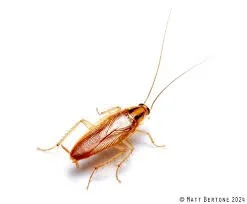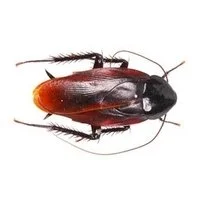
Cockroaches are among the most resilient pests a homeowner can face. In the warm, humid climate of East Texas, several species thrive and sometimes invade homes in search of food, water, and shelter. Below is a guide to the roach species you’re likeliest to encounter, how to spot them, where they hide, and why infestations are a serious concern.
Roach Facts & Information
What Are Roaches and Why Do They Matter
Cockroaches are one of the most common and troublesome pests found in East Texas homes. These insects are highly adaptable and can survive in almost any environment — from restaurants and warehouses to quiet residential kitchens. While only a few species typically invade homes, all share several key traits that make them difficult to eliminate once established.
General Characteristics of Roaches:
Flat, oval-shaped bodies that allow them to squeeze into tight cracks and crevices
Long antennae used to detect food, moisture, and danger
Six spiny legs that make them fast runners and excellent climbers
Nocturnal by nature — most activity occurs at night
Omnivorous diet — they eat crumbs, grease, decaying matter, pet food, and even paper or glue
Rapid reproduction — a single female can produce hundreds of offspring in a year
Where Roaches Hide:
Behind kitchen appliances like refrigerators, ovens, and dishwashers
Under sinks and around leaky pipes or drains
Inside cabinets, pantries, and wall voids
In basements, crawlspaces, and attics
Outdoors in woodpiles, mulch, gutters, or near foundation cracks
Why They Matter:
Health risks: Roaches can spread bacteria such as Salmonella and E. coli, contaminating food and surfaces.
Allergy triggers: Their droppings and shed skins can cause allergic reactions and asthma, particularly in children.
Unpleasant odor: Large infestations produce a strong, musty smell that can permeate the home.
Difficult to control: Roaches can hide deep inside walls, reproduce quickly, and often survive DIY treatments.
Even a small roach problem can grow quickly if not addressed. Early detection and professional pest control help prevent infestations and protect your family’s health and comfort.
-

German Cockroach
About ½ inch long; light brown or tan with two dark stripes on the back of the head. Small, fast, and often found near food and moisture. Females carry egg cases until ready to hatch. Reproduces rapidly.
Kitchens, bathrooms, behind appliances, under sinks, and inside cabinets or wall voids.
The most common indoor roach in Texas; infestations grow quickly and are difficult to eliminate without professional help.
-

American Cockroach
1½ to 2 inches long; reddish-brown with a yellow band behind the head. Large and capable of short glides or flights. Prefers warm, damp areas. Often called “palmetto bugs.”
Basements, crawlspaces, drains, sewers, boiler rooms, and sometimes kitchens or bathrooms.
Can contaminate food and surfaces; their size and flight capability make them particularly alarming indoors.
-

Oriental Cockroach
1 to 1¼ inches long; shiny black or very dark brown. Slow-moving, cannot fly, prefers cool and damp environments. Often associated with plumbing leaks or moisture issues.
Basements, crawlspaces, under sinks, around drains, and in damp outdoor areas.
Sometimes called “water bugs.” Their presence often indicates excess humidity or drainage problems.
-

Smoky Brown Cockroach
About 1¼ inches long; uniform dark brown to mahogany color. Strong fliers; often live outdoors but may move inside when conditions are right. Attracted to light and moisture.
Outdoors in woodpiles, gutters, mulch, soffits, and trees; may enter attics or around eaves.
Common outdoor invader in East Texas; sealing entry points and reducing exterior moisture is key to control.
Where Roaches Hide & How They Behave
Dark, hidden crevices — cracks in walls, baseboards, behind stoves or refrigerators, inside cabinets, under sinks.
Moisture-rich areas — leaks, plumbing, drains, humid corners, bathrooms, laundry rooms.
Warm environments — they favor warmth, so near water heaters, furnaces, boiler rooms, or near appliances.
Outdoor harborage — gutters, mulch, leaf litter, woodpiles, tree holes, overgrown vegetation, drainage areas.
Nighttime activity — roaches are mostly nocturnal. You’re most likely to see them moving at night.
Foraging trails — they follow pheromone paths to food, often along edges or behind appliances.
They scavenge almost anything: crumbs, grease, food scraps, pet food, decaying organic matter—even glue or starches from paper.
Why Roach Infestations Are Serious
Health & disease risk
Roaches can carry bacteria (Salmonella, E. coli), trigger allergies and asthma via their droppings, saliva, and shed skins.
Their presence in food-prep areas can lead to contamination.
Rapid reproduction & hidden populations
Many roaches reproduce quickly; German roaches, for example, produce many offspring and hide deep in cracks, making eradication difficult.
Egg cases (oothecae) can survive treatments, leading to resurgence.
Damage and nuisance
Roach droppings, cast skins, and odor can build up and be unsightly or smelly.
They may eat or damage nonfood materials (paper, glue, fabrics).
Difficulty of control
Roaches are adept at evading treatments, hiding deep in structural voids or behind appliances.
Outdoor–indoor exchange: species like smoky brown often reinvade from outside, making treatment more challenging.
What Homeowners Can Do & When to Call Professionals
Prevention & First Steps
Eliminate food and water sources: seal food containers, clean spills immediately, fix leaks.
Seal cracks and gaps around doors, windows, plumbing, utility lines, and foundations.
Reduce clutter and debris near the home (mulch, leaf piles, wood piles).
Use proper ventilation and dehumidifiers in damp areas.
Use sticky traps or roach monitors to detect early activity.
Why Professional Help Is Important
Pros can locate hidden nests and egg cases.
Integrated strategies (baiting, residual treatments, exclusion work) are more effective than DIY sprays alone.
Professionals can assess and treat both indoor and perimeter (outdoor) roach pressure to reduce reinfestation risk.
Don’t let roaches take over your home — protect your family and your peace of mind with professional help from Total Home Pest Solutions. Contact us today to schedule your free pest inspection and let our experts eliminate roaches at the source for good.
FAQs
1. What attracts roaches into my home?
Roaches are drawn to food, moisture, and warmth. Crumbs, grease, pet food, leaky pipes, and clutter provide ideal living conditions. Even clean homes can attract them if there are small water leaks or easy entry points.
2. Where do roaches typically hide?
Roaches prefer dark, warm, and humid spaces. Common hiding spots include under sinks, behind refrigerators, inside cabinets, around drains, and in wall voids or baseboards. They’re mostly nocturnal, so if you see one during the day, there may be a large infestation.
3. Are roaches dangerous to humans?
Yes. Roaches can carry bacteria like E. coli and Salmonella on their bodies, contaminating food and surfaces. Their shed skins and droppings can also trigger allergies and asthma, especially in children and sensitive individuals.
4. How can I tell if I have a roach infestation?
Signs include droppings that resemble coffee grounds, shed skins, egg casings, and a musty odor. You might also see live roaches scurrying when lights turn on at night.
5. Can I get rid of roaches myself?
DIY sprays and traps may kill a few visible roaches, but they rarely reach hidden nesting sites. Roaches breed rapidly — effective control requires professional treatment targeting both adults and eggs.
6. How can I prevent roaches from coming back?
Seal cracks and crevices, repair leaks, keep food sealed, empty trash frequently, and vacuum regularly. Professional pest control services can apply protective barriers and monitor for reinfestation.
7. When should I call a professional exterminator?
If you’re seeing roaches regularly, especially during the day, or notice droppings and odors, it’s time to call Total Home Pest Solutions. We’ll inspect your home, identify the species, and create a customized treatment plan to eliminate them completely.
